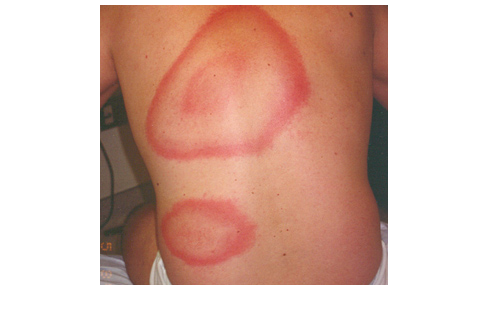Lyme Disease Treatment -
How To Treat Lyme Disease
Lyme disease treatment is a question that generally pops up as soon as a person has a suspicion that they have been infected. Lyme disease occurs when an individual is bitten by a tick that is carrying the bacteria Borrelia Burgdorferi.
This specific bacteria causes Lyme disease.
Once a person has been bitten by the infected tick, Lyme symptoms will begin to appear soon after. Symptoms such as:
- a red skin rash,
- fever,
- joint pain,
- muscle pain,
- jaw pain,
- and other systemic effects can occur.
 The red skin rash of Lyme
The red skin rash of LymeThe severity of the symptoms will depend on the severity of the infection. The more severe the infection, the worse your symptoms will be. Once Lyme disease is suspected, additional testing will be needed to confirm that the patient does in fact have Lyme disease.
Lyme disease can be confirmed via blood testing, but in an indirect method.
For more information about testing for Lyme disease, have a look at Lyme disease blood tests.
The next step after Lyme disease diagnosis is of course Lyme disease treatment. Many patients wonder, "How is Lyme disease treated?" Your doctor will discuss the treatment options available to you based on your individual clinical symptoms.
Lyme Disease Treatment -
How to treat Lyme Disease
The standard of care is antibiotic therapy. Lyme disease is a bacterial infection, and so can be treated with antibiotics. If you get antibiotics early in the stages of Lyme, you will normally recover quickly. Antibiotics such as Doxycycline, Amoxicillin, or Cefuroxime can be used in Lyme treatment.
You should check with your doctor if you are pregnant or breast-feeding in order to determine which antibiotic will provide you with the best result in eradicating the bacterial infection.
Oral antibiotics (taken by mouth) are appropriate if the infection is diagnosed in its early stages. But if you are experiencing wide-spread, systemic symptoms which include fever, then intra-venous (by injection) antibiotics may be needed. These extra symptoms include neurological (nerve) and / or cardiac (heart) problems.
The antibiotic course normally lasts between 14-21 days depending on the regimen recommended by your doctor.
Rarely, there may be complications that need extra treatment - this happened to British World Cup rugby player Matt Dawson, who needed heart surgery after getting Lyme disease from a tick bite.
Matt Dawson is famous for making the winning pass to Jonny Wilkinson in the Rugby Union World Cup against Australia. Wilkinson scored the vital points to win the World Cup. Here's the story from the British press; click on the link below the image to read the full story.
 Matt Dawson
Matt DawsonWhen deciding on the best Lyme treatment, it is very important to discuss all your available options with your healthcare provider. He or she may determine that a different treatment approach may be better for you, based on the signs and symptoms that you have.
Antibiotics is the most common way to treat lyme disease, but other additional treatments may be needed. For example, if you are dehydrated, and you are not able to take in enough fluid by mouth, then you will need intra-venous hydration in hospital.
Therefore, each Lyme disease treatment regimen WILL vary based on the patient and the systemic spread of the Lyme disease. Every case is different!



